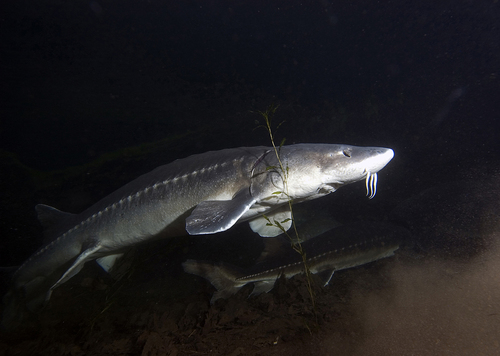
White Sturgeon
Bluefin Tuna (Thunnus spp.) are among the most iconic and commercially valuable fish in the world. Renowned for their size, speed, and strength, these apex predators play a crucial role in marine ecosystems. They are highly migratory, traveling vast distances across oceans. Bluefin Tuna are also a prized delicacy, particularly in sushi and sashimi, which has led to significant conservation concerns.
50 100 years
Lifespan
610 cm
Length
Least Concern
Conservation Status
32 km/h
Swimming speed
Carnivorous, Scavengers
Diet
Anadromous
Migration
Appearance Overview
The Bluefin Tuna is a large, streamlined fish with a metallic blue back and a silvery-white underside. Known for their robust and muscular build, they are designed for speed and endurance.
Coloration
Dark metallic blue on top, silvery-white on the belly
Body Shape
Torpedo-shaped, designed for efficient swimming
Fins
Two dorsal fins, the first depressible; small finlets behind second dorsal and anal fins
Keel
Strong lateral keel on the caudal peduncle
Length
Up to 13 feet (4 meters)
Weight
Up to 2,000 lbs (907 kg)
Diet
Carnivorous, feeding on smaller fish, squid, crustaceans, and eels
Feeding Behavior
Highly active predators, Bluefin Tuna use their speed to chase down prey. They often hunt cooperatively, herding smaller fish into tighter formations to feed more efficiently.
Social Behavior
Highly migratory, forming large schools based on size; often travels long distances across oceans
Commercial Relevance
Extremely high value, particularly in sushi and sashimi markets, where it is considered a delicacy. Prices can reach thousands of dollars per pound for premium cuts, driving its economic importance and exploitation
Conservation measures
International fishing quotas, seasonal closures, minimum size limits, and efforts to establish marine protected areas. Monitoring and research programs also aim to improve stock management and promote sustainable fishing practices
Status
Varies by species: Atlantic Bluefin Tuna - Endangered; Pacific Bluefin Tuna - Vulnerable; Southern Bluefin Tuna - Critically Endangered
Threats
Overfishing is the primary threat, driven by high demand and value. Other threats include bycatch in fishing gear, climate change affecting ocean conditions and prey availability, and habitat degradation
Habitat Distribution
Depth Range
Surface waters to depths of over 3,000 feet (1,000 meters)
Geographic Range
Widely distributed in the Atlantic, Pacific, and Indian Oceans. Key populations include the Atlantic, Pacific, and Southern Bluefin Tuna.
Preferred Environment
Primarily pelagic, inhabiting temperate and subtropical waters; often found in open ocean but can also come closer to shore, particularly near continental shelves and islands
Reproduction and Life Cycle
Breeding Habits
Spawns in specific regions such as the Gulf of Mexico and the Mediterranean Sea for Atlantic Bluefin Tuna. Pacific Bluefin Tuna spawn in areas around Japan and the Philippines. Spawning typically occurs in warm waters.
Development Stages
Eggs hatch into larvae that drift with plankton. Juveniles grow rapidly, feeding on small organisms. They gradually develop into fast-swimming predators, reaching adult size and behavior over several years.
Fecundity
Highly fecund; a single female can produce millions of eggs per spawning season, up to 30 million eggs, depending on size and condition
Maturity Age
Varies by species: Atlantic Bluefin Tuna mature at around 4-8 years, Pacific Bluefin Tuna at 3-5 years, and Southern Bluefin Tuna at 8-12 years
Faqs about White Sturgeon
How long do Bluefin Tuna live?
The lifespan can vary, but Atlantic Bluefin Tuna can live up to 40 years, while Pacific and Southern Bluefin Tuna typically live around 15-25 years.
How fast can Bluefin Tuna swim?
Bluefin Tuna are among the fastest fish in the ocean, capable of reaching speeds up to 43 mph (70 km/h) in short bursts.
Are Bluefin Tuna warm-blooded?
Bluefin Tuna are warm-blooded, maintaining a body temperature higher than the surrounding water, which helps with muscle efficiency and swimming speed.
Do Bluefin Tuna migrate?
Yes, they undertake long migrations for feeding and spawning, often crossing entire oceans.
Is Bluefin Tuna roe edible?
The roe is edible and sometimes used in Mediterranean and Japanese cuisine, but it's not as highly valued as the flesh.
Can Bluefin Tuna be farmed?
Yes, some aquaculture operations raise Bluefin Tuna, though it is challenging due to their size, migratory nature, and specific dietary needs.
Copyright @ Nature Style Limited. All Rights Reserved.
 English
English